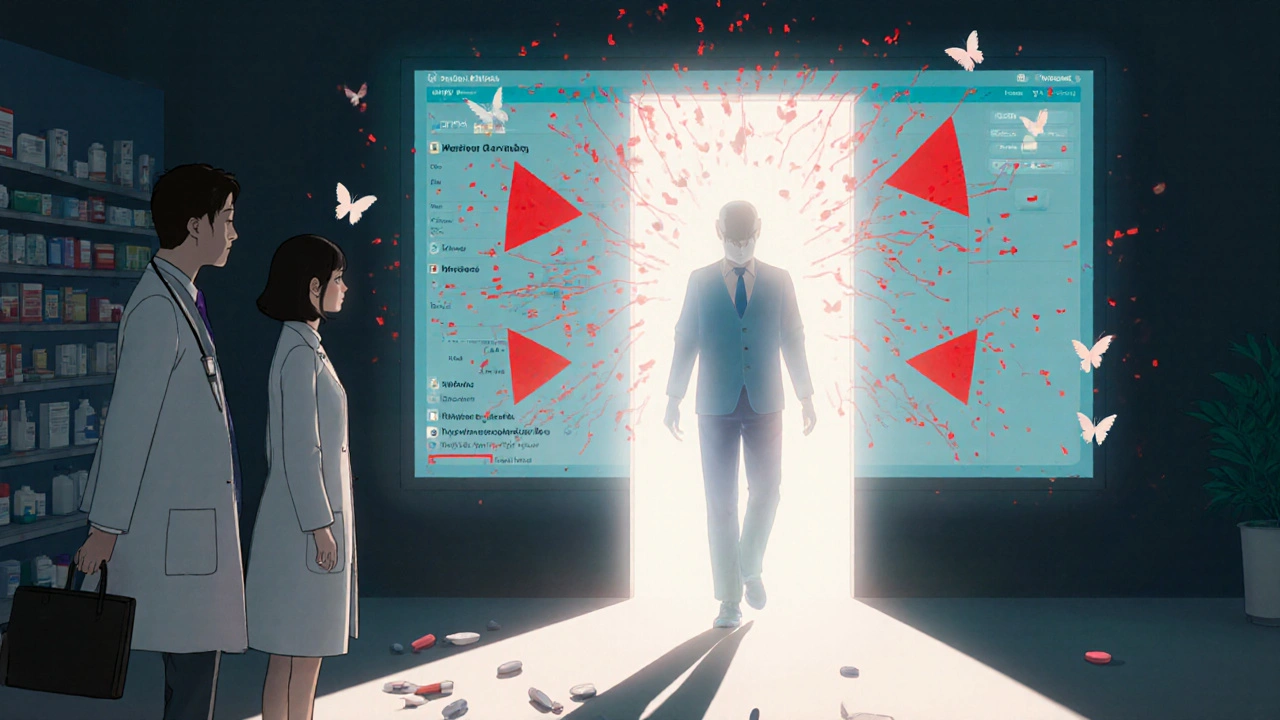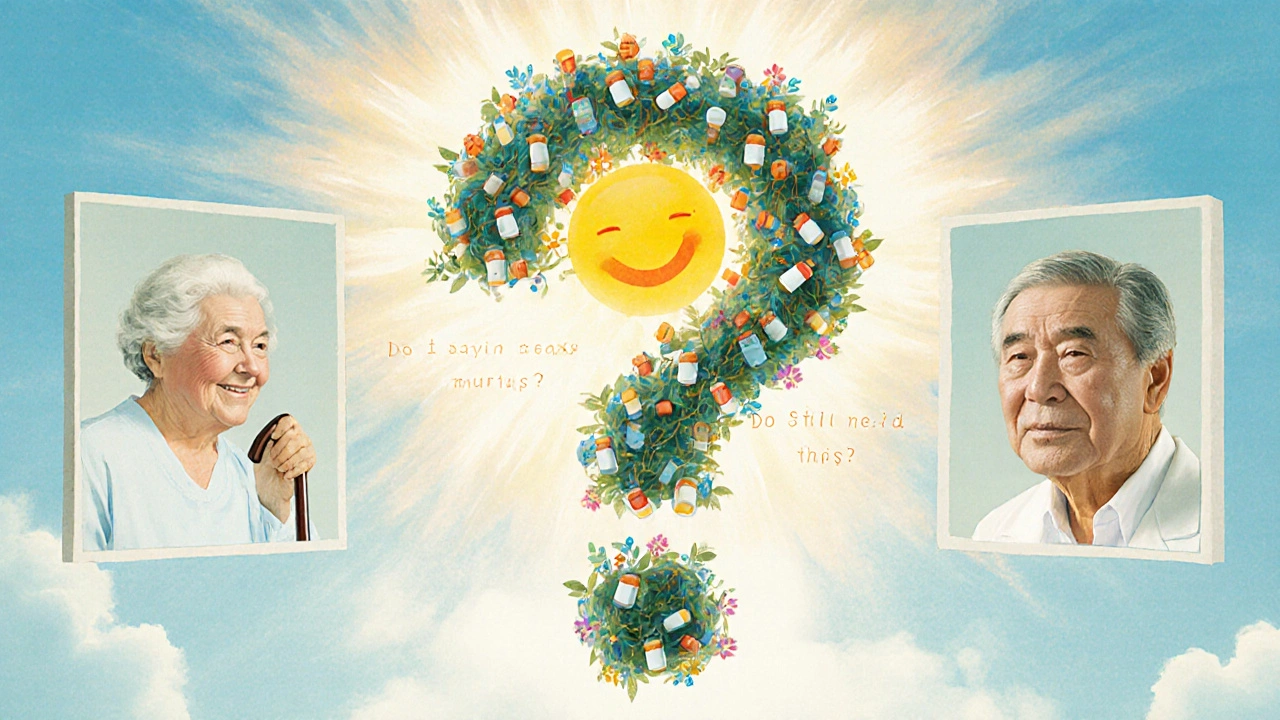Deprescribing Candidate Calculator
Find out if you're a candidate for deprescribing
This tool uses evidence-based criteria from the article to identify who may benefit from medication review and safe deprescribing. Enter the information below to assess your situation.
Your Deprescribing Candidate Status
Why Stopping Medications Can Be the Right Move
Most people assume that taking more medications means better health. But for many older adults, especially those on five or more drugs, the opposite is true. Too many pills don’t just add up-they create new problems. Dizziness. Confusion. Falls. Hospital trips. These aren’t just side effects. They’re direct results of medication overload. That’s where deprescribing comes in-not as a last resort, but as a planned, safe way to cut unnecessary drugs and actually improve quality of life.
Deprescribing isn’t about stopping everything. It’s about asking one simple question: Is this drug still helping more than it’s hurting? For someone with limited life expectancy, chronic pain, or multiple conditions, a drug meant to prevent a heart attack years down the line might be doing more harm than good today. The goal isn’t to stop meds blindly. It’s to match treatment to current needs, not past diagnoses.
What Exactly Is a Deprescribing Framework?
A deprescribing framework is a step-by-step clinical tool. Think of it like a checklist doctors and pharmacists use to decide which meds can come off safely. These aren’t guesses. They’re based on years of research, expert reviews, and real patient outcomes. The most widely used ones focus on five high-risk drug classes: proton-pump inhibitors (PPIs), benzodiazepines, antipsychotics, diabetes drugs, and opioids.
For example, the PPI deprescribing guideline gives clear steps: first, check if the patient still needs the drug for acid reflux. Many people stay on it years after their ulcer healed. Then, assess how strong the original reason was. If it was weak, start reducing the dose slowly-over 4 to 8 weeks-while watching for symptoms like heartburn returning. This isn’t just theory. A 2023 trial showed patients on this protocol cut their PPI use by 60% without worsening symptoms.
One of the most validated frameworks is called Shed-MEDS. It stands for: Best Possible Medication History, Evaluate, Deprescribing Recommendations, Synthesis. In a study of 372 older adults in post-acute care, those who went through Shed-MEDS dropped an average of 1.8 medications-and stayed that way 90 days later. Crucially, they didn’t have more falls, confusion, or hospital visits. In fact, their safety rates matched the control group that kept all their meds.
Who Benefits Most From Deprescribing?
It’s not just for frail elderly patients. It’s for anyone on multiple drugs with changing health goals. Consider these common scenarios:
- An 80-year-old with dementia who’s still on a blood thinner for a stroke they had 10 years ago-now at higher risk of bleeding from minor bumps.
- A 72-year-old with type 2 diabetes who’s on insulin but rarely leaves the house and eats very little. Their blood sugar is low most days, and they’ve had two falls in the past month.
- A 68-year-old with anxiety who’s been on a benzodiazepine for 15 years. They’ve been off work for a decade and don’t face stress triggers anymore.
In each case, the original reason for the drug may no longer apply. The risk has grown. The benefit has faded. Deprescribing frameworks help spot these mismatches.
Studies show that 40% of older adults globally take at least one potentially inappropriate medication. In U.S. nursing homes, nearly half of residents are on antipsychotics-even though only a small fraction have psychosis. These aren’t always signs of good care. Sometimes, they’re signs of inertia.

How Do You Start the Process?
Deprescribing doesn’t happen in a 7-minute doctor visit. It needs time, conversation, and teamwork. Here’s how it works in practice:
- Review the full list. Gather every prescription, over-the-counter pill, and supplement. Many patients don’t realize how many they’re taking. A pharmacist can help sort through them.
- Identify red flags. Look for drugs with known risks in older adults-like sleeping pills, anticholinergics, or long-term opioids. Use tools like the Beers Criteria or STOPP/START guidelines to flag high-risk meds.
- Ask the patient. What are their goals? Do they want to feel more alert? Walk without falling? Reduce the number of pills they swallow each day? Their priorities matter more than clinical guidelines.
- Pick one drug to start. Don’t try to remove five at once. Start with the one with the highest risk and lowest benefit. Benzodiazepines for sleep are a good first target-they’re linked to falls, memory issues, and addiction.
- Go slow. Tapering matters. Stopping a benzodiazepine cold turkey can cause seizures. Reducing PPIs too fast can cause rebound heartburn. Follow evidence-based taper schedules. Most take 4-12 weeks.
- Monitor closely. Check in weekly at first. Watch for withdrawal symptoms, return of original symptoms, or new problems. Keep a log.
Pharmacists are key here. When they’re involved, deprescribing success rates jump by 35-40%. They’re trained to spot interactions, track tapering schedules, and educate patients. In Canada, where pharmacist-led deprescribing is routine, 63% of primary care practices have formal protocols. In the U.S., it’s just 28%.
Why Isn’t Everyone Doing This?
There’s a big gap between what works and what happens in clinics. Why?
First, time. Most primary care visits last under 10 minutes. Deprescribing needs 30-45 minutes for a full review. Doctors are stretched thin. Many don’t know where to start.
Second, fear. Patients are scared. “I’ve taken this for 20 years-what if I get sick without it?” Doctors worry too. “What if I’m sued if something goes wrong?” But data says otherwise. The 2023 JAMA study showed no increase in hospitalizations or deaths after deprescribing. In fact, patients often feel better-more alert, less dizzy, fewer stomach issues.
Third, systems don’t help. Electronic health records don’t flag which drugs can be stopped. They don’t remind doctors to review meds during annual visits. They don’t even auto-populate a patient’s full list. One study found that 78% of clinicians believe deprescribing improves outcomes-but only 32% feel their EHR supports it.
And guidelines? Outdated. A 2024 analysis of 3,569 clinical recommendations found only 7% addressed deprescribing. Meanwhile, 93% focused on starting drugs. We’re trained to prescribe, not to stop.
What’s Changing Now?
Things are shifting. Fast.
In June 2024, the American Medical Association officially said doctors should routinely review all medications. That’s huge. It’s no longer optional-it’s expected.
Medicare is catching up too. Starting in 2026, doctors will be scored on how well they reduce inappropriate medications. That means hospitals and clinics will finally invest in training, tools, and staff to make this happen.
Technology is helping. AI tools are being developed to scan EHRs and flag patients who might benefit from deprescribing. One project at Columbia University is building a system that looks at age, diagnoses, and drug list-and suggests which meds to review next.
And the evidence keeps growing. A 2023 Canadian study found that for every dollar spent on pharmacist-led deprescribing, health systems saved $3.20-through fewer hospital stays, ER visits, and medication costs. That’s not just good care. It’s smart economics.

What Patients Should Know
If you’re on multiple medications, here’s what to do:
- Ask your doctor: “Which of these drugs are still necessary?”
- Bring a full list-every pill, patch, and supplement-to every visit.
- Ask: “What happens if I stop this?” and “What if I keep taking it?”
- Don’t stop anything on your own. Tapering safely matters.
- Track how you feel after a drug is reduced. More energy? Better sleep? Less dizziness? That’s feedback your doctor needs.
Many patients report feeling lighter after deprescribing. Less confusion. Fewer pills to carry. More freedom. One 81-year-old woman in a 2022 study said, “I used to spend my mornings sorting through 17 pills. Now I take five. I feel like I’ve gotten my life back.”
Where to Find Trusted Resources
You don’t need to figure this out alone. Here are free, evidence-based tools:
- deprescribing.org - Offers free, downloadable guidelines for PPIs, benzodiazepines, antipsychotics, and more. Includes step-by-step taper schedules.
- Beers Criteria (2023) - Updated every two years by the American Geriatrics Society. Lists 34 potentially inappropriate medications for older adults.
- STOPP/START Version 3 - A tool that helps identify both inappropriate prescriptions (STOPP) and missed ones (START). Used worldwide.
These aren’t just for doctors. Patients and caregivers can use them to start conversations. Print out the guidelines. Bring them to your next appointment. Ask: “Does this apply to me?”
The Bigger Picture
Deprescribing isn’t just about cutting pills. It’s about reclaiming control. It’s about treating the person, not the chart. It’s about recognizing that medicine isn’t always the answer-and sometimes, less is more.
By 2030, one in six people worldwide will be over 65. The number of older adults on multiple drugs will keep rising. If we don’t fix this, hospital stays, falls, and confusion will keep climbing too. Deprescribing frameworks give us a way out. Not by ignoring medicine-but by using it smarter.
The future of care isn’t more drugs. It’s better decisions. And that starts with asking: Do I still need this?
Is deprescribing safe?
Yes, when done properly. Multiple studies, including a 2023 randomized trial with 372 older adults, show no increase in hospitalizations, falls, or deaths after deprescribing. In fact, patients often report fewer side effects and better quality of life. The key is following evidence-based tapering schedules and monitoring closely-not stopping abruptly.
Can I stop my medications on my own?
No. Some medications, like benzodiazepines, antipsychotics, and certain diabetes or blood pressure drugs, can cause serious withdrawal symptoms if stopped suddenly. Always work with your doctor or pharmacist to create a safe, gradual tapering plan. Never stop a prescription without professional guidance.
How long does deprescribing take?
It varies by drug. For PPIs, tapering usually takes 4-8 weeks. For benzodiazepines, it can take 8-16 weeks or longer. The goal is to reduce slowly enough to avoid withdrawal, but fast enough to see benefits. Your provider will adjust the timeline based on your response and symptoms.
Who is best suited to lead deprescribing?
Pharmacists are the most effective leaders in deprescribing. They have specialized training in medication therapy management and spend more time reviewing drug lists. Studies show deprescribing success rates increase by 35-40% when pharmacists are involved. Doctors and nurse practitioners can lead it too, but they need support and time.
What if my symptoms come back after stopping a drug?
That’s why monitoring is part of the process. If symptoms return, your provider will assess whether the drug was truly unnecessary or if it needs to be restarted at a lower dose. Sometimes, the original condition has changed-like acid reflux returning after stopping a PPI. That’s not failure. It’s data. It helps refine your treatment plan.
Are there medications that should never be deprescribed?
Not exactly. Even high-risk drugs like blood thinners or insulin can be safely reduced or stopped if the patient’s condition has changed-like moving from active life to hospice care. The decision isn’t based on the drug class alone, but on the individual’s goals, function, and risk-benefit balance. A drug that’s essential for one person may be unnecessary for another.
How do I know if I’m a candidate for deprescribing?
You’re a strong candidate if you’re 65+, taking five or more medications, have had a recent fall or hospital visit, feel confused or drowsy, or want to reduce your pill burden. If you’re unsure, ask your doctor: “Could any of my medications be doing more harm than good?” That’s the first step.

